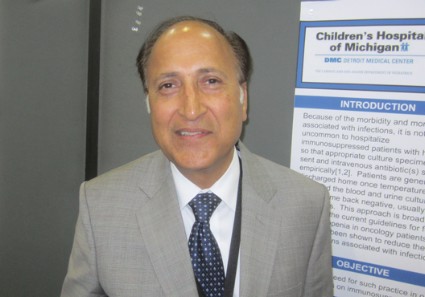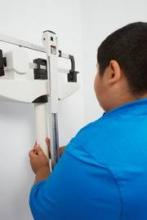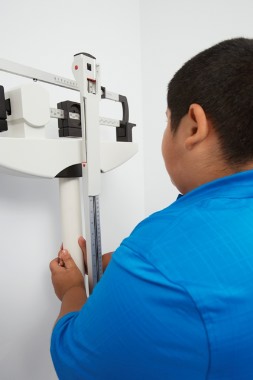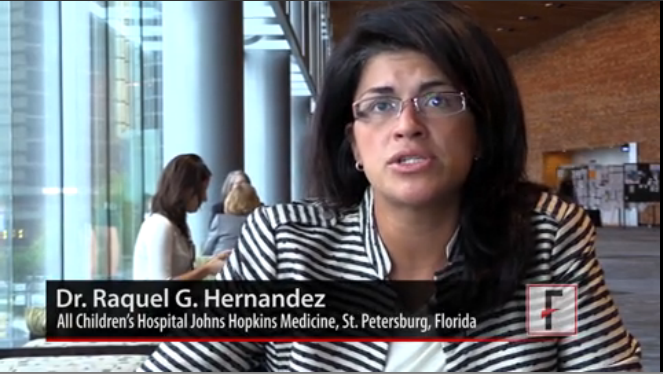User login
Pediatric Academic Societies (PAS): Annual Meeting
AAP nomogram means fewer unnecessary heel sticks for newborns
VANCOUVER, B.C. – A phototherapy nomogram from the American Academy of Pediatrics is slightly more reliable than the widely used Bhutani nomogram when it comes to deciding if transcutaneous bilirubin measurements need to be followed by a total serum bilirubin blood draw.
The conclusion is based on a retrospective chart review from the BORN (Better Outcomes Through Research for Newborns) network. The team checked 902 transcutaneous bilirubin (TCB) measurements, an estimate of total serum bilirubin (TSB) from a device that scans the skin, against actual total serum bilirubins drawn no more than 2 hours later. Their subjects were infants a mean of 35 hours old, born after at least 35 weeks’ gestation.
When skin scans indicate that newborns are in the 75th percentile for risk of severe hyperbilirubinemia on the Bhutani nomogram, blood is drawn to check the actual level. That approach missed two of 27 infants who actually had TSB levels that required phototherapy, a false-negative rate of 7.4% (95% confidence interval, 0.9%-24.3%).
When the investigators instead deemed blood draws necessary only when TCB levels were 70% or more of the American Academy of Pediatrics (AAP) threshold for phototherapy, the false-negative rate was 3.4%, with just one of 29 infants missed (95% CI 0.8%-17.8%).
Overall, the team analyzed 7,737 TCB values in a total of 4,993 infants; only a small number led to TSB blood work. They concluded that the Bhutani method would avoid unnecessary TSB blood draws in about 80% of infants, while the AAP nomogram would avoid unnecessary blood draws in about 85%.
"TCB seems like it should be a perfect thing, but a lot of people don’t really do it because they don’t believe the results; we wanted to a do a real-world study in a bunch of nurseries to see how well it really works. Our results indicate that TCB works pretty well," and that "the 70% of phototherapy threshold might be as good if not a little bit better than [Bhutani] in terms of avoiding [unnecessary] blood draws. I’m wondering if we should switch to [it]," said lead investigator Dr. James Taylor, medical director of the University of Washington’s newborn nursery in Seattle.
"The false negatives weren’t very far off. I think the highest TSB level we had was 18 mg/dL," he said at the Academic Pediatric Societies annual meeting.
A larger study is needed to confirm the difference in false negatives, he cautioned.
The study was retrospective, so clinicians used whatever TCB device they wanted. More than 60% of the infants were white, and more than 80% were born after 38 weeks.
Dr. Taylor is also working on a smart phone app to measure TCB.
He said he has no disclosures. The BORN research network is funded by the Academic Pediatric Association.
VANCOUVER, B.C. – A phototherapy nomogram from the American Academy of Pediatrics is slightly more reliable than the widely used Bhutani nomogram when it comes to deciding if transcutaneous bilirubin measurements need to be followed by a total serum bilirubin blood draw.
The conclusion is based on a retrospective chart review from the BORN (Better Outcomes Through Research for Newborns) network. The team checked 902 transcutaneous bilirubin (TCB) measurements, an estimate of total serum bilirubin (TSB) from a device that scans the skin, against actual total serum bilirubins drawn no more than 2 hours later. Their subjects were infants a mean of 35 hours old, born after at least 35 weeks’ gestation.
When skin scans indicate that newborns are in the 75th percentile for risk of severe hyperbilirubinemia on the Bhutani nomogram, blood is drawn to check the actual level. That approach missed two of 27 infants who actually had TSB levels that required phototherapy, a false-negative rate of 7.4% (95% confidence interval, 0.9%-24.3%).
When the investigators instead deemed blood draws necessary only when TCB levels were 70% or more of the American Academy of Pediatrics (AAP) threshold for phototherapy, the false-negative rate was 3.4%, with just one of 29 infants missed (95% CI 0.8%-17.8%).
Overall, the team analyzed 7,737 TCB values in a total of 4,993 infants; only a small number led to TSB blood work. They concluded that the Bhutani method would avoid unnecessary TSB blood draws in about 80% of infants, while the AAP nomogram would avoid unnecessary blood draws in about 85%.
"TCB seems like it should be a perfect thing, but a lot of people don’t really do it because they don’t believe the results; we wanted to a do a real-world study in a bunch of nurseries to see how well it really works. Our results indicate that TCB works pretty well," and that "the 70% of phototherapy threshold might be as good if not a little bit better than [Bhutani] in terms of avoiding [unnecessary] blood draws. I’m wondering if we should switch to [it]," said lead investigator Dr. James Taylor, medical director of the University of Washington’s newborn nursery in Seattle.
"The false negatives weren’t very far off. I think the highest TSB level we had was 18 mg/dL," he said at the Academic Pediatric Societies annual meeting.
A larger study is needed to confirm the difference in false negatives, he cautioned.
The study was retrospective, so clinicians used whatever TCB device they wanted. More than 60% of the infants were white, and more than 80% were born after 38 weeks.
Dr. Taylor is also working on a smart phone app to measure TCB.
He said he has no disclosures. The BORN research network is funded by the Academic Pediatric Association.
VANCOUVER, B.C. – A phototherapy nomogram from the American Academy of Pediatrics is slightly more reliable than the widely used Bhutani nomogram when it comes to deciding if transcutaneous bilirubin measurements need to be followed by a total serum bilirubin blood draw.
The conclusion is based on a retrospective chart review from the BORN (Better Outcomes Through Research for Newborns) network. The team checked 902 transcutaneous bilirubin (TCB) measurements, an estimate of total serum bilirubin (TSB) from a device that scans the skin, against actual total serum bilirubins drawn no more than 2 hours later. Their subjects were infants a mean of 35 hours old, born after at least 35 weeks’ gestation.
When skin scans indicate that newborns are in the 75th percentile for risk of severe hyperbilirubinemia on the Bhutani nomogram, blood is drawn to check the actual level. That approach missed two of 27 infants who actually had TSB levels that required phototherapy, a false-negative rate of 7.4% (95% confidence interval, 0.9%-24.3%).
When the investigators instead deemed blood draws necessary only when TCB levels were 70% or more of the American Academy of Pediatrics (AAP) threshold for phototherapy, the false-negative rate was 3.4%, with just one of 29 infants missed (95% CI 0.8%-17.8%).
Overall, the team analyzed 7,737 TCB values in a total of 4,993 infants; only a small number led to TSB blood work. They concluded that the Bhutani method would avoid unnecessary TSB blood draws in about 80% of infants, while the AAP nomogram would avoid unnecessary blood draws in about 85%.
"TCB seems like it should be a perfect thing, but a lot of people don’t really do it because they don’t believe the results; we wanted to a do a real-world study in a bunch of nurseries to see how well it really works. Our results indicate that TCB works pretty well," and that "the 70% of phototherapy threshold might be as good if not a little bit better than [Bhutani] in terms of avoiding [unnecessary] blood draws. I’m wondering if we should switch to [it]," said lead investigator Dr. James Taylor, medical director of the University of Washington’s newborn nursery in Seattle.
"The false negatives weren’t very far off. I think the highest TSB level we had was 18 mg/dL," he said at the Academic Pediatric Societies annual meeting.
A larger study is needed to confirm the difference in false negatives, he cautioned.
The study was retrospective, so clinicians used whatever TCB device they wanted. More than 60% of the infants were white, and more than 80% were born after 38 weeks.
Dr. Taylor is also working on a smart phone app to measure TCB.
He said he has no disclosures. The BORN research network is funded by the Academic Pediatric Association.
AT THE PEDIATRIC ACADEMIC SOCIETIES ANNUAL MEETING
Key clinical point: Transcutaneous bilirubins might be more reliably interpreted by using the American Academy of Pediatrics phototherapy nomogram.
Major finding: The Bhutani nomogram avoids unnecessary blood draws in about 80% of newborns and the AAP nomogram avoids unnecessary blood draws in 85%.
Data source: Retrospective review of more than 7,000 TCBs in infants a mean of 35 hours old
Disclosures: The lead investigator has no disclosures. The work was funded by the Academic Pediatric Association.
Recovery is quicker when depressed teens are guided by a treatment manager
VANCOUVER, B.C. – A proactive, collaborative care approach is best for teenage depression, according to Dr. Laura P. Richardson.
She and her team randomized 51 adolescents aged 13-17 years old who had screened positive for depression on the Patient Health Questionnaire 9 and other measures to standard care, and 50 others to a collaborative model overseen by a master’s level depression care manager.
Both groups had a mean baseline score of about 47 on the Children’s Depression Rating Scale (CDRS), but soon separated. At 6 months, 50% of the treatment group, but only 15% of the control group, had a drop of at least 50% in their CDRS score; at 1 year, the difference had grown to 70%, vs. 30%. With the majority of adolescents in each arm still involved in the project, the mean 12-month CDRS score in the collaborative care group was 26, vs. about 35 for the control group. Also at 12 months, the treatment group’s mean score on the Columbia Impairment Scale was 13.2, vs. 17.1 in the control arm. The differences were all statistically significant.
The adolescents in the collaborative arm ended up having more therapy sessions and medication, as well, and reported greater satisfaction with their care.
Often in the United States, when adolescents feeling down see their primary care physician, they walk out of the office with a list of psychotherapists to contact and maybe a short course of antidepressants, after being told to come back in a month. "They often don’t, because they aren’t doing well and aren’t motivated," said lead investigator Dr. Richardson, a specialist in adolescent medicine at Seattle Children’s Hospital.
Instead, the care manager worked with the adolescents and their parents to pick antidepressants, regular cognitive-behavioral therapy sessions, or both. The manager then checked in with them about every week and tracked how the adolescents did in a disease registry. Those who needed more help got it.
As is often the case, the usual care kids were simply encouraged to seek care for depression, Dr. Richardson noted.
The results show that "we can do better" when it comes to depressed teens. "Patient engagement and tracking are critical. Unless we engage youth up front and keep them engaged, we are probably not going to make a difference. A lot of it [comes down to] training people to be proactive, because we haven’t been," she said at the Pediatric Academic Societies annual meeting.
With just a year’s data, it’s unknown if the extra up-front costs save money down the road, though that’s been shown in adults. The model is being tried elsewhere in the country.
The mean age in the study was about 15 years, and about three-quarters of the participants were girls. Most of the adolescents were white.
The investigators excluded adolescents who were already seeing a psychiatrist; those who had developmental delays or previous mental health hospitalizations; and those who had bipolar disorder, were abusing drugs, or were unable to speak English.
Dr. Richardson said she had no relevant financial disclosures. The work was funded by the National Institute of Mental Health.
VANCOUVER, B.C. – A proactive, collaborative care approach is best for teenage depression, according to Dr. Laura P. Richardson.
She and her team randomized 51 adolescents aged 13-17 years old who had screened positive for depression on the Patient Health Questionnaire 9 and other measures to standard care, and 50 others to a collaborative model overseen by a master’s level depression care manager.
Both groups had a mean baseline score of about 47 on the Children’s Depression Rating Scale (CDRS), but soon separated. At 6 months, 50% of the treatment group, but only 15% of the control group, had a drop of at least 50% in their CDRS score; at 1 year, the difference had grown to 70%, vs. 30%. With the majority of adolescents in each arm still involved in the project, the mean 12-month CDRS score in the collaborative care group was 26, vs. about 35 for the control group. Also at 12 months, the treatment group’s mean score on the Columbia Impairment Scale was 13.2, vs. 17.1 in the control arm. The differences were all statistically significant.
The adolescents in the collaborative arm ended up having more therapy sessions and medication, as well, and reported greater satisfaction with their care.
Often in the United States, when adolescents feeling down see their primary care physician, they walk out of the office with a list of psychotherapists to contact and maybe a short course of antidepressants, after being told to come back in a month. "They often don’t, because they aren’t doing well and aren’t motivated," said lead investigator Dr. Richardson, a specialist in adolescent medicine at Seattle Children’s Hospital.
Instead, the care manager worked with the adolescents and their parents to pick antidepressants, regular cognitive-behavioral therapy sessions, or both. The manager then checked in with them about every week and tracked how the adolescents did in a disease registry. Those who needed more help got it.
As is often the case, the usual care kids were simply encouraged to seek care for depression, Dr. Richardson noted.
The results show that "we can do better" when it comes to depressed teens. "Patient engagement and tracking are critical. Unless we engage youth up front and keep them engaged, we are probably not going to make a difference. A lot of it [comes down to] training people to be proactive, because we haven’t been," she said at the Pediatric Academic Societies annual meeting.
With just a year’s data, it’s unknown if the extra up-front costs save money down the road, though that’s been shown in adults. The model is being tried elsewhere in the country.
The mean age in the study was about 15 years, and about three-quarters of the participants were girls. Most of the adolescents were white.
The investigators excluded adolescents who were already seeing a psychiatrist; those who had developmental delays or previous mental health hospitalizations; and those who had bipolar disorder, were abusing drugs, or were unable to speak English.
Dr. Richardson said she had no relevant financial disclosures. The work was funded by the National Institute of Mental Health.
VANCOUVER, B.C. – A proactive, collaborative care approach is best for teenage depression, according to Dr. Laura P. Richardson.
She and her team randomized 51 adolescents aged 13-17 years old who had screened positive for depression on the Patient Health Questionnaire 9 and other measures to standard care, and 50 others to a collaborative model overseen by a master’s level depression care manager.
Both groups had a mean baseline score of about 47 on the Children’s Depression Rating Scale (CDRS), but soon separated. At 6 months, 50% of the treatment group, but only 15% of the control group, had a drop of at least 50% in their CDRS score; at 1 year, the difference had grown to 70%, vs. 30%. With the majority of adolescents in each arm still involved in the project, the mean 12-month CDRS score in the collaborative care group was 26, vs. about 35 for the control group. Also at 12 months, the treatment group’s mean score on the Columbia Impairment Scale was 13.2, vs. 17.1 in the control arm. The differences were all statistically significant.
The adolescents in the collaborative arm ended up having more therapy sessions and medication, as well, and reported greater satisfaction with their care.
Often in the United States, when adolescents feeling down see their primary care physician, they walk out of the office with a list of psychotherapists to contact and maybe a short course of antidepressants, after being told to come back in a month. "They often don’t, because they aren’t doing well and aren’t motivated," said lead investigator Dr. Richardson, a specialist in adolescent medicine at Seattle Children’s Hospital.
Instead, the care manager worked with the adolescents and their parents to pick antidepressants, regular cognitive-behavioral therapy sessions, or both. The manager then checked in with them about every week and tracked how the adolescents did in a disease registry. Those who needed more help got it.
As is often the case, the usual care kids were simply encouraged to seek care for depression, Dr. Richardson noted.
The results show that "we can do better" when it comes to depressed teens. "Patient engagement and tracking are critical. Unless we engage youth up front and keep them engaged, we are probably not going to make a difference. A lot of it [comes down to] training people to be proactive, because we haven’t been," she said at the Pediatric Academic Societies annual meeting.
With just a year’s data, it’s unknown if the extra up-front costs save money down the road, though that’s been shown in adults. The model is being tried elsewhere in the country.
The mean age in the study was about 15 years, and about three-quarters of the participants were girls. Most of the adolescents were white.
The investigators excluded adolescents who were already seeing a psychiatrist; those who had developmental delays or previous mental health hospitalizations; and those who had bipolar disorder, were abusing drugs, or were unable to speak English.
Dr. Richardson said she had no relevant financial disclosures. The work was funded by the National Institute of Mental Health.
AT THE PAS ANNUAL MEETING
Key clinical point: Outcomes are better – and, ultimately, costs are probably lower – when a master’s level manager oversees the treatment of depressed teens.
Major finding: After 6 months, 50% of the depressed teens assigned to collaborative care, but just 15% of those assigned to usual care had a drop of at least 50% in their Child Depression Rating Scale score, a significant difference.
Data source: A randomized trial of 101 depressed teenagers.
Disclosures: Dr. Richardson said she had no relevant financial disclosures. The work was funded by the National Institute of Mental Health.
Bottom Line on Maternal Infections and Cerebral Palsy
VANCOUVER, B.C. – Intra- or extra-amniotic fluid infections during pregnancy elevate the risk of having a child with cerebral palsy, according to analysis of 6 million California birth records – although the findings shows an association, not causality.
Researchers showed that pregnant women who were hospitalized with a diagnosis of chorioamnionitis had a fourfold increase in the risk of having a child with cerebral palsy (CP), while genitourinary and respiratory infections increased that risk twofold.
"I think this is a very important study, and it took us a step further in trying to understand what could cause cerebral palsy," said Dr. Lee M. Sanders, associate professor of pediatrics and codirector of the Center for Policy, Outcomes, and Prevention at Stanford (Calif.) University.
Because the study shows an association only, however, "it’s important not to cause alarm," cautioned Dr. Sanders, who was not involved in the study.
In a video interview, Dr. Sanders explains what’s known so far about this association, the implications of the study’s findings, and the research that’s already underway.
The video associated with this article is no longer available on this site. Please view all of our videos on the MDedge YouTube channel
On Twitter @naseemmiller
VANCOUVER, B.C. – Intra- or extra-amniotic fluid infections during pregnancy elevate the risk of having a child with cerebral palsy, according to analysis of 6 million California birth records – although the findings shows an association, not causality.
Researchers showed that pregnant women who were hospitalized with a diagnosis of chorioamnionitis had a fourfold increase in the risk of having a child with cerebral palsy (CP), while genitourinary and respiratory infections increased that risk twofold.
"I think this is a very important study, and it took us a step further in trying to understand what could cause cerebral palsy," said Dr. Lee M. Sanders, associate professor of pediatrics and codirector of the Center for Policy, Outcomes, and Prevention at Stanford (Calif.) University.
Because the study shows an association only, however, "it’s important not to cause alarm," cautioned Dr. Sanders, who was not involved in the study.
In a video interview, Dr. Sanders explains what’s known so far about this association, the implications of the study’s findings, and the research that’s already underway.
The video associated with this article is no longer available on this site. Please view all of our videos on the MDedge YouTube channel
On Twitter @naseemmiller
VANCOUVER, B.C. – Intra- or extra-amniotic fluid infections during pregnancy elevate the risk of having a child with cerebral palsy, according to analysis of 6 million California birth records – although the findings shows an association, not causality.
Researchers showed that pregnant women who were hospitalized with a diagnosis of chorioamnionitis had a fourfold increase in the risk of having a child with cerebral palsy (CP), while genitourinary and respiratory infections increased that risk twofold.
"I think this is a very important study, and it took us a step further in trying to understand what could cause cerebral palsy," said Dr. Lee M. Sanders, associate professor of pediatrics and codirector of the Center for Policy, Outcomes, and Prevention at Stanford (Calif.) University.
Because the study shows an association only, however, "it’s important not to cause alarm," cautioned Dr. Sanders, who was not involved in the study.
In a video interview, Dr. Sanders explains what’s known so far about this association, the implications of the study’s findings, and the research that’s already underway.
The video associated with this article is no longer available on this site. Please view all of our videos on the MDedge YouTube channel
On Twitter @naseemmiller
AT THE PAS ANNUAL MEETING
VIDEO: Bottom line on maternal infections and cerebral palsy
VANCOUVER, B.C. – Intra- or extra-amniotic fluid infections during pregnancy elevate the risk of having a child with cerebral palsy, according to analysis of 6 million California birth records – although the findings shows an association, not causality.
Researchers showed that pregnant women who were hospitalized with a diagnosis of chorioamnionitis had a fourfold increase in the risk of having a child with cerebral palsy (CP), while genitourinary and respiratory infections increased that risk twofold.
"I think this is a very important study, and it took us a step further in trying to understand what could cause cerebral palsy," said Dr. Lee M. Sanders, associate professor of pediatrics and codirector of the Center for Policy, Outcomes, and Prevention at Stanford (Calif.) University.
Because the study shows an association only, however, "it’s important not to cause alarm," cautioned Dr. Sanders, who was not involved in the study.
In a video interview, Dr. Sanders explains what’s known so far about this association, the implications of the study’s findings, and the research that’s already underway.
The video associated with this article is no longer available on this site. Please view all of our videos on the MDedge YouTube channel
On Twitter @naseemmiller
VANCOUVER, B.C. – Intra- or extra-amniotic fluid infections during pregnancy elevate the risk of having a child with cerebral palsy, according to analysis of 6 million California birth records – although the findings shows an association, not causality.
Researchers showed that pregnant women who were hospitalized with a diagnosis of chorioamnionitis had a fourfold increase in the risk of having a child with cerebral palsy (CP), while genitourinary and respiratory infections increased that risk twofold.
"I think this is a very important study, and it took us a step further in trying to understand what could cause cerebral palsy," said Dr. Lee M. Sanders, associate professor of pediatrics and codirector of the Center for Policy, Outcomes, and Prevention at Stanford (Calif.) University.
Because the study shows an association only, however, "it’s important not to cause alarm," cautioned Dr. Sanders, who was not involved in the study.
In a video interview, Dr. Sanders explains what’s known so far about this association, the implications of the study’s findings, and the research that’s already underway.
The video associated with this article is no longer available on this site. Please view all of our videos on the MDedge YouTube channel
On Twitter @naseemmiller
VANCOUVER, B.C. – Intra- or extra-amniotic fluid infections during pregnancy elevate the risk of having a child with cerebral palsy, according to analysis of 6 million California birth records – although the findings shows an association, not causality.
Researchers showed that pregnant women who were hospitalized with a diagnosis of chorioamnionitis had a fourfold increase in the risk of having a child with cerebral palsy (CP), while genitourinary and respiratory infections increased that risk twofold.
"I think this is a very important study, and it took us a step further in trying to understand what could cause cerebral palsy," said Dr. Lee M. Sanders, associate professor of pediatrics and codirector of the Center for Policy, Outcomes, and Prevention at Stanford (Calif.) University.
Because the study shows an association only, however, "it’s important not to cause alarm," cautioned Dr. Sanders, who was not involved in the study.
In a video interview, Dr. Sanders explains what’s known so far about this association, the implications of the study’s findings, and the research that’s already underway.
The video associated with this article is no longer available on this site. Please view all of our videos on the MDedge YouTube channel
On Twitter @naseemmiller
AT THE PAS ANNUAL MEETING
Maternal infections associated with increased risk of cerebral palsy
VANCOUVER, B.C. – Intra- or extra-amniotic fluid infections during pregnancy are associated with an increased risk of having a child with cerebral palsy, according to analysis of six million California birth records.
Researchers found that pregnant women who were hospitalized with diagnosis of chorioamnionitis had a fourfold increase in risk of having a child with cerebral palsy (CP), while genitourinary and respiratory infections increased that risk by twofold, each.
"I think this is a very important study, and it took us a step further in trying to understand what could cause cerebral palsy," said Dr. Lee M. Sanders, associate professor of pediatrics and codirector of the Center for Policy, Outcomes, and Prevention at Stanford (Calif.) University. But because the study shows an association only, "it’s important not to cause alarm," said Dr. Sanders, who was not involved in the study.
Dr. Joshua Bear of the University of California, San Francisco, and his colleagues analyzed the California birth records from 1991 to 2001, in addition to records of all children receiving services for CP from the California Department of Developmental Services through 2006.
There were close to 8,500 CP cases, or 1.4 per 1,000 live births, which is at the lower end of some of the reported statistics, Dr. Bear said.
Analysis of infection diagnoses showed that 6% of the women had unaffected births, while 15.3% had children with CP, with a relative risk of 2.7. Among the latter group, 7.6% had chorioamnionitis, 5.2% had other genitourinary infections, and 3.5% had respiratory infections.
Among women hospitalized with chorioamnionitis, there was a fourfold increase in risk of having CP in preterm infants and twofold increase in term births. Most women hospitalized with chorioamnionitis gave birth at that hospitalization, said Dr. Bear.
For other genitourinary infections, there was a 1.4-fold increase in the risk of CP for prenatal hospitalization, and 1.9-fold increase for birth hospitalization.
Respiratory infections showed a similar trend, with a twofold increased risk for prenatal hospitalization and 2.6-fold increase risk for birth hospitalization.
Increased risk of CP with other genitourinary and respiratory infections, even during prenatal hospitalization, suggest that "these infections may be directly or indirectly contributing to harm on the developing fetal brain and not be simply another complication during delivery," Dr. Bear said during his presentation at the annual meeting of Pediatric Academic Societies.
Analysis of sociodemographic risk factors showed that women younger than 18 and older than 35 were more likely to have a child with CP. Black women were at a higher risk of CP, compared with white and Hispanic women, and Asian women were at lower risk. Years of education was inversely associated with the risk of CP. Also, male infants were at a slightly higher risk of CP than were their female counterparts.
Yet when researchers adjusted for maternal age, race, education, socioeconomic status, and infant sex, the association between infections and increased risk of CP remained the same.
Dr. Bear and his colleagues also stratified the data by presence of birth asphyxia, to find clues if it could be a cause for CP. The results showed a large drop in rate ratios of chorioamnionitis, from 4 to 1.5 when asphyxia was diagnosed at birth, but the rates for other genitourinary and respiratory infections remained the same. "This suggests that there’s some interaction between chorioamnionitis and presence of birth asphyxia, although the nature of that interaction is unclear." said Dr. Bear.
The study had several limitations, including the use of ICD-9 codes, researchers’ inability to account for comorbid conditions related to hospitalization, and being limited to hospital-based diagnoses.
The findings, said Dr. Bear, highlighted the need for further research in several areas, including the association between CP and respiratory infections, and whether risk of CP can be decreased by preventing or treating the infections.
The findings can also "help us with public health interventions, such as better rates of influenza vaccinations among pregnant women," said Dr. Sanders.
Dr. Bear and Dr. Sanders had no relevant disclosures.
On Twitter @naseemmiller
VANCOUVER, B.C. – Intra- or extra-amniotic fluid infections during pregnancy are associated with an increased risk of having a child with cerebral palsy, according to analysis of six million California birth records.
Researchers found that pregnant women who were hospitalized with diagnosis of chorioamnionitis had a fourfold increase in risk of having a child with cerebral palsy (CP), while genitourinary and respiratory infections increased that risk by twofold, each.
"I think this is a very important study, and it took us a step further in trying to understand what could cause cerebral palsy," said Dr. Lee M. Sanders, associate professor of pediatrics and codirector of the Center for Policy, Outcomes, and Prevention at Stanford (Calif.) University. But because the study shows an association only, "it’s important not to cause alarm," said Dr. Sanders, who was not involved in the study.
Dr. Joshua Bear of the University of California, San Francisco, and his colleagues analyzed the California birth records from 1991 to 2001, in addition to records of all children receiving services for CP from the California Department of Developmental Services through 2006.
There were close to 8,500 CP cases, or 1.4 per 1,000 live births, which is at the lower end of some of the reported statistics, Dr. Bear said.
Analysis of infection diagnoses showed that 6% of the women had unaffected births, while 15.3% had children with CP, with a relative risk of 2.7. Among the latter group, 7.6% had chorioamnionitis, 5.2% had other genitourinary infections, and 3.5% had respiratory infections.
Among women hospitalized with chorioamnionitis, there was a fourfold increase in risk of having CP in preterm infants and twofold increase in term births. Most women hospitalized with chorioamnionitis gave birth at that hospitalization, said Dr. Bear.
For other genitourinary infections, there was a 1.4-fold increase in the risk of CP for prenatal hospitalization, and 1.9-fold increase for birth hospitalization.
Respiratory infections showed a similar trend, with a twofold increased risk for prenatal hospitalization and 2.6-fold increase risk for birth hospitalization.
Increased risk of CP with other genitourinary and respiratory infections, even during prenatal hospitalization, suggest that "these infections may be directly or indirectly contributing to harm on the developing fetal brain and not be simply another complication during delivery," Dr. Bear said during his presentation at the annual meeting of Pediatric Academic Societies.
Analysis of sociodemographic risk factors showed that women younger than 18 and older than 35 were more likely to have a child with CP. Black women were at a higher risk of CP, compared with white and Hispanic women, and Asian women were at lower risk. Years of education was inversely associated with the risk of CP. Also, male infants were at a slightly higher risk of CP than were their female counterparts.
Yet when researchers adjusted for maternal age, race, education, socioeconomic status, and infant sex, the association between infections and increased risk of CP remained the same.
Dr. Bear and his colleagues also stratified the data by presence of birth asphyxia, to find clues if it could be a cause for CP. The results showed a large drop in rate ratios of chorioamnionitis, from 4 to 1.5 when asphyxia was diagnosed at birth, but the rates for other genitourinary and respiratory infections remained the same. "This suggests that there’s some interaction between chorioamnionitis and presence of birth asphyxia, although the nature of that interaction is unclear." said Dr. Bear.
The study had several limitations, including the use of ICD-9 codes, researchers’ inability to account for comorbid conditions related to hospitalization, and being limited to hospital-based diagnoses.
The findings, said Dr. Bear, highlighted the need for further research in several areas, including the association between CP and respiratory infections, and whether risk of CP can be decreased by preventing or treating the infections.
The findings can also "help us with public health interventions, such as better rates of influenza vaccinations among pregnant women," said Dr. Sanders.
Dr. Bear and Dr. Sanders had no relevant disclosures.
On Twitter @naseemmiller
VANCOUVER, B.C. – Intra- or extra-amniotic fluid infections during pregnancy are associated with an increased risk of having a child with cerebral palsy, according to analysis of six million California birth records.
Researchers found that pregnant women who were hospitalized with diagnosis of chorioamnionitis had a fourfold increase in risk of having a child with cerebral palsy (CP), while genitourinary and respiratory infections increased that risk by twofold, each.
"I think this is a very important study, and it took us a step further in trying to understand what could cause cerebral palsy," said Dr. Lee M. Sanders, associate professor of pediatrics and codirector of the Center for Policy, Outcomes, and Prevention at Stanford (Calif.) University. But because the study shows an association only, "it’s important not to cause alarm," said Dr. Sanders, who was not involved in the study.
Dr. Joshua Bear of the University of California, San Francisco, and his colleagues analyzed the California birth records from 1991 to 2001, in addition to records of all children receiving services for CP from the California Department of Developmental Services through 2006.
There were close to 8,500 CP cases, or 1.4 per 1,000 live births, which is at the lower end of some of the reported statistics, Dr. Bear said.
Analysis of infection diagnoses showed that 6% of the women had unaffected births, while 15.3% had children with CP, with a relative risk of 2.7. Among the latter group, 7.6% had chorioamnionitis, 5.2% had other genitourinary infections, and 3.5% had respiratory infections.
Among women hospitalized with chorioamnionitis, there was a fourfold increase in risk of having CP in preterm infants and twofold increase in term births. Most women hospitalized with chorioamnionitis gave birth at that hospitalization, said Dr. Bear.
For other genitourinary infections, there was a 1.4-fold increase in the risk of CP for prenatal hospitalization, and 1.9-fold increase for birth hospitalization.
Respiratory infections showed a similar trend, with a twofold increased risk for prenatal hospitalization and 2.6-fold increase risk for birth hospitalization.
Increased risk of CP with other genitourinary and respiratory infections, even during prenatal hospitalization, suggest that "these infections may be directly or indirectly contributing to harm on the developing fetal brain and not be simply another complication during delivery," Dr. Bear said during his presentation at the annual meeting of Pediatric Academic Societies.
Analysis of sociodemographic risk factors showed that women younger than 18 and older than 35 were more likely to have a child with CP. Black women were at a higher risk of CP, compared with white and Hispanic women, and Asian women were at lower risk. Years of education was inversely associated with the risk of CP. Also, male infants were at a slightly higher risk of CP than were their female counterparts.
Yet when researchers adjusted for maternal age, race, education, socioeconomic status, and infant sex, the association between infections and increased risk of CP remained the same.
Dr. Bear and his colleagues also stratified the data by presence of birth asphyxia, to find clues if it could be a cause for CP. The results showed a large drop in rate ratios of chorioamnionitis, from 4 to 1.5 when asphyxia was diagnosed at birth, but the rates for other genitourinary and respiratory infections remained the same. "This suggests that there’s some interaction between chorioamnionitis and presence of birth asphyxia, although the nature of that interaction is unclear." said Dr. Bear.
The study had several limitations, including the use of ICD-9 codes, researchers’ inability to account for comorbid conditions related to hospitalization, and being limited to hospital-based diagnoses.
The findings, said Dr. Bear, highlighted the need for further research in several areas, including the association between CP and respiratory infections, and whether risk of CP can be decreased by preventing or treating the infections.
The findings can also "help us with public health interventions, such as better rates of influenza vaccinations among pregnant women," said Dr. Sanders.
Dr. Bear and Dr. Sanders had no relevant disclosures.
On Twitter @naseemmiller
AT THE PAS ANNUAL MEETING
Key clinical finding: The association between maternal infections and increased risk of CP could be a call for public health interventions, such as higher rate of flu vaccination for pregnant women.
Major finding: Pregnant women who were hospitalized with diagnosis of chorioamnionitis had a fourfold increase in risk of having a child with cerebral palsy (CP), while genitourinary and respiratory infections increased that risk by twofold, each.
Data source: Analysis of California birth records from 1991 to 2001, and records of all children receiving services for CP from the California Department of Developmental Services through 2006.
Disclosures: Dr. Bear and Dr. Sanders had no relevant disclosures.
Late preterm births linked to school-age neurodevelopmental problems
VANCOUVER, B.C. – Late preterm infants have a higher incidence of future neurodevelopmental problems than children born at term, two studies showed.
"Everyone has just assumed that late preterm babies are fine, and there are no long-term problems. We are now finding that the outcomes are probably not as good, and [we] need to find out whether just being born [early] is the problem, or whether it’s being born [early] and having something else going on," said investigator Dr. Elaine Boyle of the University of Leicester (England).
In the first project, a team from the University of Iowa in Iowa City performed structural brain MRIs on 52 children an average of 9.4 years old who were born at 34-36 weeks, and 74 children with a mean age of 10 years born at term. All were singletons.
Among other findings, the mean volume of subcortical tissue was almost a quarter standard deviation lower in late preterm (LPT) children than in children born at term, a difference driven mostly by smaller thalami and hippocampi. "The structural difference on MRI directly related to areas in which the LPT cohort performed more poorly" on a battery of assessments, especially visual short-term memory (Pearson coefficient [r] = 0.3; P = .001) and processing speed (r = 0.2; P = .03), said lead investigator Dr. Jane Brumbaugh of the department of pediatrics at the University of Iowa.
At assessment, LPT children were 36 kg and 138 cm tall on average, with a head circumference of 54 cm. Children born at term were a bit bigger, an average of about 38 kg and 142 cm tall, with a head circumference of 55 cm. The analysis controlled for age, sex, and intracranial volume; there were no statistically significant between-group socioeconomic differences.
Meanwhile, Dr. Boyle’s team found that 16% (101/638) of infants born at 32-36 weeks, but just 10% (77/765) of term infants, had neurodevelopmental disabilities at age 2, according to the children’s parents (RR, 1.4; 95% CI, 1.1-2.0; P = .011).
The finding comes from the PARCA-R (Parent Report of Children’s Abilities–Revised), which the Leicester team administered to parents of 2-year-olds; the investigators did not confirm their findings with clinical assessments. Their results were adjusted for sex, socioeconomic status, and multiple births.
Parents also reported that 1.6% (10) of LPT but 0.3% (2) of term infants have some type of sensory impairment, and that LPT children show a trend toward more communication problems.
Male sex, lower socioeconomic status, prepregnancy hypertension, preeclampsia, and recreational drug use during pregnancy each more than doubled the risk of neurodevelopmental disability in LPT children.
"Late to moderately preterm infants have a 50% increased risk for neurodevelopmental disability at 2 years of age. As we see in the very preterm population, this is largely driven by cognitive problems," said lead investigator Samantha Johnson, Ph.D., of the University of Leicester.
Besides arguing for term birth when possible, intervening in preeclampsia, recreational drug use, and other problems might improve outcomes. Also, it might be a good idea to screen parents of LPT infants to identify children who could benefit from early intervention, she said.
The investigators said they have no relevant financial disclosures. The University of Iowa funded the MRI study, and the U.K. National Institute for Health Research funded the English study.
VANCOUVER, B.C. – Late preterm infants have a higher incidence of future neurodevelopmental problems than children born at term, two studies showed.
"Everyone has just assumed that late preterm babies are fine, and there are no long-term problems. We are now finding that the outcomes are probably not as good, and [we] need to find out whether just being born [early] is the problem, or whether it’s being born [early] and having something else going on," said investigator Dr. Elaine Boyle of the University of Leicester (England).
In the first project, a team from the University of Iowa in Iowa City performed structural brain MRIs on 52 children an average of 9.4 years old who were born at 34-36 weeks, and 74 children with a mean age of 10 years born at term. All were singletons.
Among other findings, the mean volume of subcortical tissue was almost a quarter standard deviation lower in late preterm (LPT) children than in children born at term, a difference driven mostly by smaller thalami and hippocampi. "The structural difference on MRI directly related to areas in which the LPT cohort performed more poorly" on a battery of assessments, especially visual short-term memory (Pearson coefficient [r] = 0.3; P = .001) and processing speed (r = 0.2; P = .03), said lead investigator Dr. Jane Brumbaugh of the department of pediatrics at the University of Iowa.
At assessment, LPT children were 36 kg and 138 cm tall on average, with a head circumference of 54 cm. Children born at term were a bit bigger, an average of about 38 kg and 142 cm tall, with a head circumference of 55 cm. The analysis controlled for age, sex, and intracranial volume; there were no statistically significant between-group socioeconomic differences.
Meanwhile, Dr. Boyle’s team found that 16% (101/638) of infants born at 32-36 weeks, but just 10% (77/765) of term infants, had neurodevelopmental disabilities at age 2, according to the children’s parents (RR, 1.4; 95% CI, 1.1-2.0; P = .011).
The finding comes from the PARCA-R (Parent Report of Children’s Abilities–Revised), which the Leicester team administered to parents of 2-year-olds; the investigators did not confirm their findings with clinical assessments. Their results were adjusted for sex, socioeconomic status, and multiple births.
Parents also reported that 1.6% (10) of LPT but 0.3% (2) of term infants have some type of sensory impairment, and that LPT children show a trend toward more communication problems.
Male sex, lower socioeconomic status, prepregnancy hypertension, preeclampsia, and recreational drug use during pregnancy each more than doubled the risk of neurodevelopmental disability in LPT children.
"Late to moderately preterm infants have a 50% increased risk for neurodevelopmental disability at 2 years of age. As we see in the very preterm population, this is largely driven by cognitive problems," said lead investigator Samantha Johnson, Ph.D., of the University of Leicester.
Besides arguing for term birth when possible, intervening in preeclampsia, recreational drug use, and other problems might improve outcomes. Also, it might be a good idea to screen parents of LPT infants to identify children who could benefit from early intervention, she said.
The investigators said they have no relevant financial disclosures. The University of Iowa funded the MRI study, and the U.K. National Institute for Health Research funded the English study.
VANCOUVER, B.C. – Late preterm infants have a higher incidence of future neurodevelopmental problems than children born at term, two studies showed.
"Everyone has just assumed that late preterm babies are fine, and there are no long-term problems. We are now finding that the outcomes are probably not as good, and [we] need to find out whether just being born [early] is the problem, or whether it’s being born [early] and having something else going on," said investigator Dr. Elaine Boyle of the University of Leicester (England).
In the first project, a team from the University of Iowa in Iowa City performed structural brain MRIs on 52 children an average of 9.4 years old who were born at 34-36 weeks, and 74 children with a mean age of 10 years born at term. All were singletons.
Among other findings, the mean volume of subcortical tissue was almost a quarter standard deviation lower in late preterm (LPT) children than in children born at term, a difference driven mostly by smaller thalami and hippocampi. "The structural difference on MRI directly related to areas in which the LPT cohort performed more poorly" on a battery of assessments, especially visual short-term memory (Pearson coefficient [r] = 0.3; P = .001) and processing speed (r = 0.2; P = .03), said lead investigator Dr. Jane Brumbaugh of the department of pediatrics at the University of Iowa.
At assessment, LPT children were 36 kg and 138 cm tall on average, with a head circumference of 54 cm. Children born at term were a bit bigger, an average of about 38 kg and 142 cm tall, with a head circumference of 55 cm. The analysis controlled for age, sex, and intracranial volume; there were no statistically significant between-group socioeconomic differences.
Meanwhile, Dr. Boyle’s team found that 16% (101/638) of infants born at 32-36 weeks, but just 10% (77/765) of term infants, had neurodevelopmental disabilities at age 2, according to the children’s parents (RR, 1.4; 95% CI, 1.1-2.0; P = .011).
The finding comes from the PARCA-R (Parent Report of Children’s Abilities–Revised), which the Leicester team administered to parents of 2-year-olds; the investigators did not confirm their findings with clinical assessments. Their results were adjusted for sex, socioeconomic status, and multiple births.
Parents also reported that 1.6% (10) of LPT but 0.3% (2) of term infants have some type of sensory impairment, and that LPT children show a trend toward more communication problems.
Male sex, lower socioeconomic status, prepregnancy hypertension, preeclampsia, and recreational drug use during pregnancy each more than doubled the risk of neurodevelopmental disability in LPT children.
"Late to moderately preterm infants have a 50% increased risk for neurodevelopmental disability at 2 years of age. As we see in the very preterm population, this is largely driven by cognitive problems," said lead investigator Samantha Johnson, Ph.D., of the University of Leicester.
Besides arguing for term birth when possible, intervening in preeclampsia, recreational drug use, and other problems might improve outcomes. Also, it might be a good idea to screen parents of LPT infants to identify children who could benefit from early intervention, she said.
The investigators said they have no relevant financial disclosures. The University of Iowa funded the MRI study, and the U.K. National Institute for Health Research funded the English study.
AT THE PAS ANNUAL MEETING
Key clinical point: Besides arguing for term birth, if possible, the findings suggest a need for early intervention.
Major finding: At age 10, the mean volume of subcortical tissue in late preterm children is almost a quarter standard deviation lower than in children born at term; at age 2, 16% of LPT children have neurodevelopmental disabilities, versus 10% of children born at term, according to their parents.
Data source: An MRI study of 126 2-year-olds and a population cohort study of 1,403 English school children
Disclosures: The investigators said they have no relevant financial disclosures. The MRI study was funded by the University of Iowa, and the English study was funded by the U.K. National Institute for Health Research.
No need to hospitalize febrile immunosuppressed kids who are otherwise well
VANCOUVER, B.C. – Immunosuppressed children with fever who are otherwise well can be managed as outpatients pending culture results, and don’t need to be routinely admitted to the hospital, according to a retrospective review from the Children’s Hospital of Michigan, Detroit.
Among 103 admissions involving 60 immunosuppressed children with fever above 38.3º C, 79 (76.6%) admissions were of children who were okay outside of the fever, and 24 (23.4%) were of children who presented with low blood pressure, tachycardia, abnormal cardiac/chest auscultation, abdominal tenderness, or abnormal lab results.
The children who were doing well didn’t really need to go into the hospital, according to Dr. Tej K. Mattoo, the study’s senior investigator. Five admissions were of children ultimately diagnosed with strep pharyngitis, two with otitis media, and two with urinary tract infections. There were just two positive cultures in the group, both urine, and no positive chest x-rays. Outpatient management would have been fine, Dr. Mattoo said at the annual meeting of the Pediatric Academic Societies.
Admission turned out to be the wise choice, however, in 20 of 24 (83.3%) cases with significant presentations. Among them were eight cases of pneumonia, five abscesses, and one case each of peritonitis, sepsis, and acute gastritis. There were two positive blood cultures, four positive urine cultures, three positive wound cultures, one positive peritoneal culture, and a positive Clostridium difficile test.
The research team concluded that "immunosuppressed renal patients with high fever and insignificant clinical findings do not need routine hospitalization; they could be sent home with appropriate counseling/follow-up after culture specimens are collected."
The findings help define who can be safely sent home, and who needs to go upstairs, said Dr. Mattoo, chief of pediatric nephrology and hypertension at Children’s.
"The way it works now is that we routinely admit children on immunosuppression who have high fever. Once they are in, they stay in hospital at least for 3 days as you wait for the culture results. It turns out that about 75% of the patients in our study could have been managed as outpatients. A lot of it depends on a good history and physical. When things other than the fever are normal, that gives you a high comfort level to tell parents ‘I can send your child home’ " with appropriate outpatient care and pledges to bring the child back if things get worse and to check up on culture results in a few days, he said.
The average age at admission was 9 years, and about 60% of the admissions were boys. The children had nephrotic syndrome, systemic lupus erythematosus, or kidney transplants. Most were on two or three immunosuppressives, generally some combination of prednisone, mycophenolate mofetil, and tacrolimus/sirolimus. Patients with diabetes, cardiorespiratory disease, or lupus flares were excluded from the investigation.
Dr. Mattoo has no disclosures relevant to the study, and the work had no outside funding.
VANCOUVER, B.C. – Immunosuppressed children with fever who are otherwise well can be managed as outpatients pending culture results, and don’t need to be routinely admitted to the hospital, according to a retrospective review from the Children’s Hospital of Michigan, Detroit.
Among 103 admissions involving 60 immunosuppressed children with fever above 38.3º C, 79 (76.6%) admissions were of children who were okay outside of the fever, and 24 (23.4%) were of children who presented with low blood pressure, tachycardia, abnormal cardiac/chest auscultation, abdominal tenderness, or abnormal lab results.
The children who were doing well didn’t really need to go into the hospital, according to Dr. Tej K. Mattoo, the study’s senior investigator. Five admissions were of children ultimately diagnosed with strep pharyngitis, two with otitis media, and two with urinary tract infections. There were just two positive cultures in the group, both urine, and no positive chest x-rays. Outpatient management would have been fine, Dr. Mattoo said at the annual meeting of the Pediatric Academic Societies.
Admission turned out to be the wise choice, however, in 20 of 24 (83.3%) cases with significant presentations. Among them were eight cases of pneumonia, five abscesses, and one case each of peritonitis, sepsis, and acute gastritis. There were two positive blood cultures, four positive urine cultures, three positive wound cultures, one positive peritoneal culture, and a positive Clostridium difficile test.
The research team concluded that "immunosuppressed renal patients with high fever and insignificant clinical findings do not need routine hospitalization; they could be sent home with appropriate counseling/follow-up after culture specimens are collected."
The findings help define who can be safely sent home, and who needs to go upstairs, said Dr. Mattoo, chief of pediatric nephrology and hypertension at Children’s.
"The way it works now is that we routinely admit children on immunosuppression who have high fever. Once they are in, they stay in hospital at least for 3 days as you wait for the culture results. It turns out that about 75% of the patients in our study could have been managed as outpatients. A lot of it depends on a good history and physical. When things other than the fever are normal, that gives you a high comfort level to tell parents ‘I can send your child home’ " with appropriate outpatient care and pledges to bring the child back if things get worse and to check up on culture results in a few days, he said.
The average age at admission was 9 years, and about 60% of the admissions were boys. The children had nephrotic syndrome, systemic lupus erythematosus, or kidney transplants. Most were on two or three immunosuppressives, generally some combination of prednisone, mycophenolate mofetil, and tacrolimus/sirolimus. Patients with diabetes, cardiorespiratory disease, or lupus flares were excluded from the investigation.
Dr. Mattoo has no disclosures relevant to the study, and the work had no outside funding.
VANCOUVER, B.C. – Immunosuppressed children with fever who are otherwise well can be managed as outpatients pending culture results, and don’t need to be routinely admitted to the hospital, according to a retrospective review from the Children’s Hospital of Michigan, Detroit.
Among 103 admissions involving 60 immunosuppressed children with fever above 38.3º C, 79 (76.6%) admissions were of children who were okay outside of the fever, and 24 (23.4%) were of children who presented with low blood pressure, tachycardia, abnormal cardiac/chest auscultation, abdominal tenderness, or abnormal lab results.
The children who were doing well didn’t really need to go into the hospital, according to Dr. Tej K. Mattoo, the study’s senior investigator. Five admissions were of children ultimately diagnosed with strep pharyngitis, two with otitis media, and two with urinary tract infections. There were just two positive cultures in the group, both urine, and no positive chest x-rays. Outpatient management would have been fine, Dr. Mattoo said at the annual meeting of the Pediatric Academic Societies.
Admission turned out to be the wise choice, however, in 20 of 24 (83.3%) cases with significant presentations. Among them were eight cases of pneumonia, five abscesses, and one case each of peritonitis, sepsis, and acute gastritis. There were two positive blood cultures, four positive urine cultures, three positive wound cultures, one positive peritoneal culture, and a positive Clostridium difficile test.
The research team concluded that "immunosuppressed renal patients with high fever and insignificant clinical findings do not need routine hospitalization; they could be sent home with appropriate counseling/follow-up after culture specimens are collected."
The findings help define who can be safely sent home, and who needs to go upstairs, said Dr. Mattoo, chief of pediatric nephrology and hypertension at Children’s.
"The way it works now is that we routinely admit children on immunosuppression who have high fever. Once they are in, they stay in hospital at least for 3 days as you wait for the culture results. It turns out that about 75% of the patients in our study could have been managed as outpatients. A lot of it depends on a good history and physical. When things other than the fever are normal, that gives you a high comfort level to tell parents ‘I can send your child home’ " with appropriate outpatient care and pledges to bring the child back if things get worse and to check up on culture results in a few days, he said.
The average age at admission was 9 years, and about 60% of the admissions were boys. The children had nephrotic syndrome, systemic lupus erythematosus, or kidney transplants. Most were on two or three immunosuppressives, generally some combination of prednisone, mycophenolate mofetil, and tacrolimus/sirolimus. Patients with diabetes, cardiorespiratory disease, or lupus flares were excluded from the investigation.
Dr. Mattoo has no disclosures relevant to the study, and the work had no outside funding.
AT THE PAS ANNUAL MEETING
Key clinical point: If immunosuppressed children with fever are otherwise fine, they probably don’t need to be admitted.
Major finding: Of 103 hospital admissions of immunosuppressed children for fever, 79 (76.6%) could have been managed as outpatients.
Data Source: Retrospective review.
Disclosures: The senior investigator has no relevant disclosures, and the work didn’t receive any outside funding.
Tubby toddlers: Don’t delay the tough conversation
VANCOUVER, B.C. – Very few overweight and obese children outgrow their at-risk weight, and the window to address the problem is fairly narrow.
Dr. Raquel G. Hernandez, assistant professor of pediatrics at Johns Hopkins University, and her colleagues looked at obesity resilience, seeking to identify the prevalence of favorable growth patterns, such as healthy weight maintenance and return to healthy weight in school-aged children.
"There are pervasive expectations among parents that their children will magically outgrow their weight risk, and unfortunately, I think this applies to some providers as well," Dr. Hernandez said at the annual meeting of the Pediatric Academic Societies.
The researchers analyzed data on more than 9,000 children in the Early Childhood Longitudinal Study database, looking at their growth during the elementary school years. Measurements included body mass index (BMI), race/ethnicity, gender, and socioeconomic status and were compared for kindergarten, first, third, and fifth grade.
At baseline, nearly 26% of children were overweight or obese, while most (70%) were classified as healthy weight (BMI from the fifth through the 85th percentile). The rest were underweight. The majority of the cohort maintained healthy weight, but less than one in five (17%) of the overweight or obese children were able to return to healthy weight (BMI between the 5th and 85th percentile) over the study period.
In this unpublished study, Hispanic boys and girls were less likely to return to healthy weight, compared with children of other races/ethnicities. Boys of all races/ethnicities and socioeconomic statuses were more likely to be persistently overweight or obese. For girls, middle and low socioeconomic status was associated with lower likelihood of returning to healthy body weight.
"Most surprisingly, in contrast to pervasive expectations, greatest incidence of outgrowth occurred in overweight kids during kindergarten to first grade," said Dr. Hernandez, who is also associate director of medical education at All Children’s Hospital Johns Hopkins Medicine in St. Petersburg, Fla.
Less than 5% of children returned to healthy weight after third grade, she said.
"It’s time to open [the conversation about weight], and also parents should be open about having that conversation, knowing that outgrowth doesn’t really happen as frequently as we thought it would," Dr. Hernandez said in an interview.
The study had several limitations, she said. A portion of children weren’t included in the analysis because of missing relevant data, leading to potential for selection bias. Also, the criteria for return to healthy weight and healthy weight maintenance might have led to exclusion of children who made favorable transitions, the authors said.
"Curbing the pediatric obesity epidemic will depend on exploring all growth trends in children, including the potential for obesity-resilient growth patterns," said Dr. Hernandez. Future work should seek ways to help "clinicians to more deliberately message healthy weight maintenance and explore how these patterns can be more robustly discussed among children who are at risk, especially Hispanic children and children who have low socioeconomic status," she added.
Dr. Hernandez reported no financial disclosures. The research was funded by an institutional grant from the All Children’s Hospital Johns Hopkins Foundation.
On Twitter @naseemmiller
VANCOUVER, B.C. – Very few overweight and obese children outgrow their at-risk weight, and the window to address the problem is fairly narrow.
Dr. Raquel G. Hernandez, assistant professor of pediatrics at Johns Hopkins University, and her colleagues looked at obesity resilience, seeking to identify the prevalence of favorable growth patterns, such as healthy weight maintenance and return to healthy weight in school-aged children.
"There are pervasive expectations among parents that their children will magically outgrow their weight risk, and unfortunately, I think this applies to some providers as well," Dr. Hernandez said at the annual meeting of the Pediatric Academic Societies.
The researchers analyzed data on more than 9,000 children in the Early Childhood Longitudinal Study database, looking at their growth during the elementary school years. Measurements included body mass index (BMI), race/ethnicity, gender, and socioeconomic status and were compared for kindergarten, first, third, and fifth grade.
At baseline, nearly 26% of children were overweight or obese, while most (70%) were classified as healthy weight (BMI from the fifth through the 85th percentile). The rest were underweight. The majority of the cohort maintained healthy weight, but less than one in five (17%) of the overweight or obese children were able to return to healthy weight (BMI between the 5th and 85th percentile) over the study period.
In this unpublished study, Hispanic boys and girls were less likely to return to healthy weight, compared with children of other races/ethnicities. Boys of all races/ethnicities and socioeconomic statuses were more likely to be persistently overweight or obese. For girls, middle and low socioeconomic status was associated with lower likelihood of returning to healthy body weight.
"Most surprisingly, in contrast to pervasive expectations, greatest incidence of outgrowth occurred in overweight kids during kindergarten to first grade," said Dr. Hernandez, who is also associate director of medical education at All Children’s Hospital Johns Hopkins Medicine in St. Petersburg, Fla.
Less than 5% of children returned to healthy weight after third grade, she said.
"It’s time to open [the conversation about weight], and also parents should be open about having that conversation, knowing that outgrowth doesn’t really happen as frequently as we thought it would," Dr. Hernandez said in an interview.
The study had several limitations, she said. A portion of children weren’t included in the analysis because of missing relevant data, leading to potential for selection bias. Also, the criteria for return to healthy weight and healthy weight maintenance might have led to exclusion of children who made favorable transitions, the authors said.
"Curbing the pediatric obesity epidemic will depend on exploring all growth trends in children, including the potential for obesity-resilient growth patterns," said Dr. Hernandez. Future work should seek ways to help "clinicians to more deliberately message healthy weight maintenance and explore how these patterns can be more robustly discussed among children who are at risk, especially Hispanic children and children who have low socioeconomic status," she added.
Dr. Hernandez reported no financial disclosures. The research was funded by an institutional grant from the All Children’s Hospital Johns Hopkins Foundation.
On Twitter @naseemmiller
VANCOUVER, B.C. – Very few overweight and obese children outgrow their at-risk weight, and the window to address the problem is fairly narrow.
Dr. Raquel G. Hernandez, assistant professor of pediatrics at Johns Hopkins University, and her colleagues looked at obesity resilience, seeking to identify the prevalence of favorable growth patterns, such as healthy weight maintenance and return to healthy weight in school-aged children.
"There are pervasive expectations among parents that their children will magically outgrow their weight risk, and unfortunately, I think this applies to some providers as well," Dr. Hernandez said at the annual meeting of the Pediatric Academic Societies.
The researchers analyzed data on more than 9,000 children in the Early Childhood Longitudinal Study database, looking at their growth during the elementary school years. Measurements included body mass index (BMI), race/ethnicity, gender, and socioeconomic status and were compared for kindergarten, first, third, and fifth grade.
At baseline, nearly 26% of children were overweight or obese, while most (70%) were classified as healthy weight (BMI from the fifth through the 85th percentile). The rest were underweight. The majority of the cohort maintained healthy weight, but less than one in five (17%) of the overweight or obese children were able to return to healthy weight (BMI between the 5th and 85th percentile) over the study period.
In this unpublished study, Hispanic boys and girls were less likely to return to healthy weight, compared with children of other races/ethnicities. Boys of all races/ethnicities and socioeconomic statuses were more likely to be persistently overweight or obese. For girls, middle and low socioeconomic status was associated with lower likelihood of returning to healthy body weight.
"Most surprisingly, in contrast to pervasive expectations, greatest incidence of outgrowth occurred in overweight kids during kindergarten to first grade," said Dr. Hernandez, who is also associate director of medical education at All Children’s Hospital Johns Hopkins Medicine in St. Petersburg, Fla.
Less than 5% of children returned to healthy weight after third grade, she said.
"It’s time to open [the conversation about weight], and also parents should be open about having that conversation, knowing that outgrowth doesn’t really happen as frequently as we thought it would," Dr. Hernandez said in an interview.
The study had several limitations, she said. A portion of children weren’t included in the analysis because of missing relevant data, leading to potential for selection bias. Also, the criteria for return to healthy weight and healthy weight maintenance might have led to exclusion of children who made favorable transitions, the authors said.
"Curbing the pediatric obesity epidemic will depend on exploring all growth trends in children, including the potential for obesity-resilient growth patterns," said Dr. Hernandez. Future work should seek ways to help "clinicians to more deliberately message healthy weight maintenance and explore how these patterns can be more robustly discussed among children who are at risk, especially Hispanic children and children who have low socioeconomic status," she added.
Dr. Hernandez reported no financial disclosures. The research was funded by an institutional grant from the All Children’s Hospital Johns Hopkins Foundation.
On Twitter @naseemmiller
AT THE PAS ANNUAL MEETING
Key clinical point: Intervene before the first grade to help overweight or obese children achieve a healthy weight.
Major finding: Only 17% of children outgrew their at-risk weight by fifth grade.
Data source: Longitudinal analysis of the Early Childhood Longitudinal Study database.
Disclosures: Dr. Hernandez reported no financial disclosures. The research was funded by an institutional grant from the All Children’s Hospital Johns Hopkins Foundation.
VIDEO: How to talk to parents about kids’ obesity
VANCOUVER, B.C. – Many overweight and obese children don’t outgrow their risk as they get older – and if they do, it’s usually between kindergarten and first grade, according to a longitudinal study that followed kindergartners to fifth grade.
But how should physicians open up the conversation with parents about their children’s obesity risks?
In this video interview at the annual meeting of the Pediatric Academic Societies, Dr. Raquel G. Hernandez, the study’s lead investigator who is with the department of pediatrics at the Johns Hopkins University School and is the associate director of medical education at All Children’s Hospital Johns Hopkins Medicine, St. Petersburg, Fla., shares her practice tips for talking with parents.
On Twitter @naseemmiller
VANCOUVER, B.C. – Many overweight and obese children don’t outgrow their risk as they get older – and if they do, it’s usually between kindergarten and first grade, according to a longitudinal study that followed kindergartners to fifth grade.
But how should physicians open up the conversation with parents about their children’s obesity risks?
In this video interview at the annual meeting of the Pediatric Academic Societies, Dr. Raquel G. Hernandez, the study’s lead investigator who is with the department of pediatrics at the Johns Hopkins University School and is the associate director of medical education at All Children’s Hospital Johns Hopkins Medicine, St. Petersburg, Fla., shares her practice tips for talking with parents.
On Twitter @naseemmiller
VANCOUVER, B.C. – Many overweight and obese children don’t outgrow their risk as they get older – and if they do, it’s usually between kindergarten and first grade, according to a longitudinal study that followed kindergartners to fifth grade.
But how should physicians open up the conversation with parents about their children’s obesity risks?
In this video interview at the annual meeting of the Pediatric Academic Societies, Dr. Raquel G. Hernandez, the study’s lead investigator who is with the department of pediatrics at the Johns Hopkins University School and is the associate director of medical education at All Children’s Hospital Johns Hopkins Medicine, St. Petersburg, Fla., shares her practice tips for talking with parents.
On Twitter @naseemmiller
AT THE PAS ANNUAL MEETING
Housing code violations are marker for asthma risk
VANCOUVER, B.C. – Pediatricians and public health professionals can estimate children’s asthma risk based on the density of housing code violations in their neighborhood, according to a retrospective cohort study reported at the annual meeting of the Pediatric Academic Societies.
Investigators led by Dr. Andrew F. Beck, of the pediatrics department at Cincinnati Children’s Hospital Medical Center, calculated the density of asthma-relevant housing code violations – those for cockroaches, rodents, mold, and water damage – for 113 neighborhoods (census tracts) in the Greater Cincinnati area.
Analyses showed that this density was significantly and positively associated with the neighborhood’s rate of pediatric asthma-related emergency department (ED) visits and hospital admissions.
Also, among the subset of patients who were admitted for asthma, the odds of another ED visit or admission in the next year increased with the density of violations. It was elevated by more than 50% for those living in neighborhoods with a medium-high or high density of violations relative to those living in neighborhoods with a low density.
"A measure of housing code violation density ... was found to be significantly correlated with asthma utilization rates at the population level, and significantly and independently associated with reutilization at the patient level," Dr. Beck commented.
"In an era where home visits are rare, local geographic data that highlight the impact of context on health provide a virtual home or neighborhood visit. Such information could help to identify upstream areas where disparity reduction can be targeted within care delivery, a focus especially relevant for diseases like asthma that are heavily impacted by the quality of one’s surroundings," he maintained.
"We expect that local risk-specific data can influence delivery of public health services more proactively. For example, the pairing of housing data with outcome data could facilitate identification of geographic areas likely to benefit from targeted housing assessments and actions," Dr. Beck added. "We also believe that contextual housing data can be integrated into clinical care. Such information could rapidly inform and drive focused interventions for connections to housing experts; for example, patients could be more efficiently connected to social workers, home health providers, and community partners such as legal advocates and community health workers, all of whom may be more suited to handling underlying housing risks than the medical team."
Study results showed that across neighborhoods, the median density of asthma-relevant housing code violations was 11 per 1,000 homes and apartments, with a range from 0 to 120, according to Dr. Beck.
The investigators identified 8,736 asthma-related ED visits and admissions to Cincinnati Children’s Hospital Medical Center by children aged 1-16 years during the study period. As the neighborhood density of housing code violations increased, so did this rate (r = 0.59; P less than .0001).
Moreover, the association remained significant after adjustment for neighborhood poverty level. Overall, the density of violations accounted for 25% of the variation across neighborhoods in such asthma-related health care use.
Among 1,531 pediatric patients with an index hospital admission for asthma, 37% had another ED visit or admission during a year of follow-up.
In a multivariate analysis, the adjusted odds of such repeat use increased with the neighborhood housing code violation density. Relative to peers living in neighborhoods with low density, children living in ones with medium-high density or high density had a significantly elevated risk (odds ratios, 1.54 and 1.84, respectively).
"In our region, housing assessments are complaint-driven; thus, the true breadth of violations is unknown," Dr. Beck noted, addressing study limitations. Also, generalizability is unclear; "we expect that many jurisdictions, however, collect similar data and use that data in similar ways."
Dr. Beck disclosed no relevant conflicts of interest.
VANCOUVER, B.C. – Pediatricians and public health professionals can estimate children’s asthma risk based on the density of housing code violations in their neighborhood, according to a retrospective cohort study reported at the annual meeting of the Pediatric Academic Societies.
Investigators led by Dr. Andrew F. Beck, of the pediatrics department at Cincinnati Children’s Hospital Medical Center, calculated the density of asthma-relevant housing code violations – those for cockroaches, rodents, mold, and water damage – for 113 neighborhoods (census tracts) in the Greater Cincinnati area.
Analyses showed that this density was significantly and positively associated with the neighborhood’s rate of pediatric asthma-related emergency department (ED) visits and hospital admissions.
Also, among the subset of patients who were admitted for asthma, the odds of another ED visit or admission in the next year increased with the density of violations. It was elevated by more than 50% for those living in neighborhoods with a medium-high or high density of violations relative to those living in neighborhoods with a low density.
"A measure of housing code violation density ... was found to be significantly correlated with asthma utilization rates at the population level, and significantly and independently associated with reutilization at the patient level," Dr. Beck commented.
"In an era where home visits are rare, local geographic data that highlight the impact of context on health provide a virtual home or neighborhood visit. Such information could help to identify upstream areas where disparity reduction can be targeted within care delivery, a focus especially relevant for diseases like asthma that are heavily impacted by the quality of one’s surroundings," he maintained.
"We expect that local risk-specific data can influence delivery of public health services more proactively. For example, the pairing of housing data with outcome data could facilitate identification of geographic areas likely to benefit from targeted housing assessments and actions," Dr. Beck added. "We also believe that contextual housing data can be integrated into clinical care. Such information could rapidly inform and drive focused interventions for connections to housing experts; for example, patients could be more efficiently connected to social workers, home health providers, and community partners such as legal advocates and community health workers, all of whom may be more suited to handling underlying housing risks than the medical team."
Study results showed that across neighborhoods, the median density of asthma-relevant housing code violations was 11 per 1,000 homes and apartments, with a range from 0 to 120, according to Dr. Beck.
The investigators identified 8,736 asthma-related ED visits and admissions to Cincinnati Children’s Hospital Medical Center by children aged 1-16 years during the study period. As the neighborhood density of housing code violations increased, so did this rate (r = 0.59; P less than .0001).
Moreover, the association remained significant after adjustment for neighborhood poverty level. Overall, the density of violations accounted for 25% of the variation across neighborhoods in such asthma-related health care use.
Among 1,531 pediatric patients with an index hospital admission for asthma, 37% had another ED visit or admission during a year of follow-up.
In a multivariate analysis, the adjusted odds of such repeat use increased with the neighborhood housing code violation density. Relative to peers living in neighborhoods with low density, children living in ones with medium-high density or high density had a significantly elevated risk (odds ratios, 1.54 and 1.84, respectively).
"In our region, housing assessments are complaint-driven; thus, the true breadth of violations is unknown," Dr. Beck noted, addressing study limitations. Also, generalizability is unclear; "we expect that many jurisdictions, however, collect similar data and use that data in similar ways."
Dr. Beck disclosed no relevant conflicts of interest.
VANCOUVER, B.C. – Pediatricians and public health professionals can estimate children’s asthma risk based on the density of housing code violations in their neighborhood, according to a retrospective cohort study reported at the annual meeting of the Pediatric Academic Societies.
Investigators led by Dr. Andrew F. Beck, of the pediatrics department at Cincinnati Children’s Hospital Medical Center, calculated the density of asthma-relevant housing code violations – those for cockroaches, rodents, mold, and water damage – for 113 neighborhoods (census tracts) in the Greater Cincinnati area.
Analyses showed that this density was significantly and positively associated with the neighborhood’s rate of pediatric asthma-related emergency department (ED) visits and hospital admissions.
Also, among the subset of patients who were admitted for asthma, the odds of another ED visit or admission in the next year increased with the density of violations. It was elevated by more than 50% for those living in neighborhoods with a medium-high or high density of violations relative to those living in neighborhoods with a low density.
"A measure of housing code violation density ... was found to be significantly correlated with asthma utilization rates at the population level, and significantly and independently associated with reutilization at the patient level," Dr. Beck commented.
"In an era where home visits are rare, local geographic data that highlight the impact of context on health provide a virtual home or neighborhood visit. Such information could help to identify upstream areas where disparity reduction can be targeted within care delivery, a focus especially relevant for diseases like asthma that are heavily impacted by the quality of one’s surroundings," he maintained.
"We expect that local risk-specific data can influence delivery of public health services more proactively. For example, the pairing of housing data with outcome data could facilitate identification of geographic areas likely to benefit from targeted housing assessments and actions," Dr. Beck added. "We also believe that contextual housing data can be integrated into clinical care. Such information could rapidly inform and drive focused interventions for connections to housing experts; for example, patients could be more efficiently connected to social workers, home health providers, and community partners such as legal advocates and community health workers, all of whom may be more suited to handling underlying housing risks than the medical team."
Study results showed that across neighborhoods, the median density of asthma-relevant housing code violations was 11 per 1,000 homes and apartments, with a range from 0 to 120, according to Dr. Beck.
The investigators identified 8,736 asthma-related ED visits and admissions to Cincinnati Children’s Hospital Medical Center by children aged 1-16 years during the study period. As the neighborhood density of housing code violations increased, so did this rate (r = 0.59; P less than .0001).
Moreover, the association remained significant after adjustment for neighborhood poverty level. Overall, the density of violations accounted for 25% of the variation across neighborhoods in such asthma-related health care use.
Among 1,531 pediatric patients with an index hospital admission for asthma, 37% had another ED visit or admission during a year of follow-up.
In a multivariate analysis, the adjusted odds of such repeat use increased with the neighborhood housing code violation density. Relative to peers living in neighborhoods with low density, children living in ones with medium-high density or high density had a significantly elevated risk (odds ratios, 1.54 and 1.84, respectively).
"In our region, housing assessments are complaint-driven; thus, the true breadth of violations is unknown," Dr. Beck noted, addressing study limitations. Also, generalizability is unclear; "we expect that many jurisdictions, however, collect similar data and use that data in similar ways."
Dr. Beck disclosed no relevant conflicts of interest.
AT THE PAS ANNUAL MEETING
Key clinical point: Children’s asthma risk can be estimated based on the density of housing code violations in their neighborhood.
Major finding: The density of housing code violations explained 25% of the variation in pediatric asthma-related health care use across neighborhoods, and hospitalized children from higher-density neighborhoods had increased odds of repeat use.
Data source: A retrospective cohort study of 113 neighborhoods, 8,736 pediatric asthma-related ED visits and admissions, and 1,531 children admitted for asthma.
Disclosures: Dr. Beck disclosed no relevant conflicts of interest.














